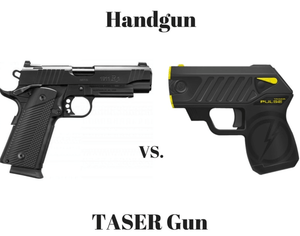Introduction
When it comes to self-defense, choosing the right tool is all about what makes you feel confident and prepared. One of the most debated comparisons out there? Handguns vs. Tasers: which is better?
Both handguns and Tasers are trusted for self-defense and even relied upon by law enforcement. But the truth is, these tools serve very different purposes. And when it comes to non-lethal self-defense options like stun guns and Tasers, let’s be honest—the media hasn’t always portrayed them accurately.
Here’s the bottom line: no matter what self-defense weapon you choose, training and safety are the most important factors. It’s not just the tool that matters; it’s how prepared and responsible you are in using it.
In this guide, we’ll compare the effectiveness, safety, and practicality of handguns and Tasers. We’ll cover everything from stopping power and distance to accuracy and real-world application.
Let’s dive in and explore which option might be the best fit for your self-defense needs.
Handgun Overview
In recent years, self-defense has become one of the leading reasons gun owners invest in firearms. Protecting your family and home is a top priority, and handguns remain one of the most reliable tools for personal protection.
What makes a good self-defense pistol? The gun community values handguns because of their stopping power, accuracy, and reliability. A well-chosen handgun can deliver decisive power at critical moments, with the ability to neutralize threats quickly and effectively.
For many, 9mm handguns are a go-to option for self-defense weapons. Their compact design makes them easy to carry, while manageable recoil allows for accurate follow-up shots—an essential feature in high-pressure situations.
This is why accuracy plays a key role when choosing a handgun for self-defense. A gun’s design allows for precise aiming at close to medium ranges, at 10 yards. Practicing at the range—whether at 25, 50, or even longer distances—can give shooters the confidence to respond effectively when it matters most.
Of course, every firearm comes with great responsibility so regular practice is crucial. Handguns are lethal self-defense tools, and safety should always come first.
And if you haven’t already, be sure to check out Gun Safety Guide for a comprehensive breakdown of how to use and store your firearm responsibly.
Now, let’s talk about tasers, one of the most popular firearm alternatives for self-defense.
Taser Overview
What is a Taser? A Taser is a type of electric shock weapon designed for non-lethal self-defense. While some people use the term interchangeably with stun guns, “Taser” is actually a specific brand. These non-lethal weapons are widely used by law enforcement and are also available for civilian self-defense.
How Does a Taser Work? Tasers use two small probes connected to thin wires that deliver an electrical charge when deployed. You shoot, the probes fire out, and both must hit the target to work.
Once connected, the Taser sends a controlled electrical pulse designed to disrupt the target’s nervous system—a process called neuromuscular incapacitation (NMI). This temporarily immobilizes the attacker by interfering with their ability to control their muscles.
How effective are Tasers? The effects of a Taser wear off almost immediately after the electrical current stops, allowing the attacker to recover quickly and without lasting side effects.
The electrical current in a Taser is low, with high voltage but low amperage. While voltage may sound intimidating, it’s the amperage that causes harm, and Tasers are specifically designed to avoid causing permanent injury.
Civilian Tasers have a maximum range of about 15 feet, while law enforcement models can reach up to 35 feet. However, for a Taser to work, the probes must land at least 12 inches apart on the target. If one probe misses or fails to penetrate clothing, the Taser won’t be effective.
What about the Taser lasting electroshock effects we often see in TV shows? Well, not quite. Unlike the dramatic, instant incapacitation often depicted in media, Tasers don’t magically disable an attacker. While they can temporarily disable an individual, the effects wear off quickly, allowing the target to recover with no lasting side effects.
This makes Tasers effective in scenarios where lethal force isn’t necessary, such as when law enforcement deals with an unarmed but aggressive individual.
Are Tasers The Same as Stun Guns?

Tasers are not the same as stun guns. While both fall under the same category, there are key differences between them. Tasers can deploy probes from a distance, while stun guns require direct physical contact to work.
Additionally, stun guns rely on pain to subdue an attacker, whereas Tasers use neuromuscular incapacitation to temporarily disable them without causing pain.
With this clarified, let’s get back to talking about Tasers vs handguns, and which is the best option for self-defense.
Handgun vs Taser Comparison
As we said at the beginning of this post, both tasers and handguns are designed to protect, but they function very differently. So let’s compare them side by side.
Effectiveness: Stopping Power vs. Incapacitation
Handguns deliver decisive stopping power at greater ranges, making them a reliable option in high-stakes, life-threatening situations. With proper aim and training, a handgun can neutralize a threat quickly and effectively.
Tasers, on the other hand, rely on temporary electrical incapacitation. While a Taser can incapacitate a target for up to 30 seconds, the effects are short-lived, and the attacker may recover quickly.
It is worth noting that Tasers are less effective against determined attackers, particularly those under the influence of drugs or adrenaline. Also, their limited range and the need for both probes to hit the target make them more challenging to use under stress.
Safety Profiles
Safety is paramount when handling any weapon. On their side, the lethal potential of handguns demands strict adherence to safe handling, secure storage, and regular training.
Tasers, while less-lethal, can still pose risks. For example, the temporary incapacitation caused by a Taser can result in additional harm if the target falls or hits the ground. In some cases, Tasers can cause side effects such as abnormal brain function, seizures, or even loss of consciousness.
Accessibility
Tasers have fewer restrictions across states, but you should always check local law. It’s true that they do not require the same level of background checks as handguns, making them easier to purchase. However, as with any weapon, specific restrictions may apply.
Technical Specs
Tech specs vary depending on the weapon model, so here we will compare specific models. One of the most popular choices for non-lethal self-defense is the Taser Pulse. As for firearms, the Canik TP9 Elite SC stands out as our top pick for the best handgun for self-defense.
So let’s make a side-by-side comparison:
While similar in size, the Taser Pulse is noticeably lighter. This is no surprise, as they are made of polymer, a less durable material compared to the steel and aluminum construction found in most handguns, including the TP9 Elite SC.
When it comes to capacity, the difference is even more striking. The Taser Pulse offers just one or two shots at best before needing to reload. By contrast, the TP9 Elite SC features a 15-round magazine, providing significantly more versatility and reliability in high-pressure scenarios.
In short, these are the specs of both:
Taser Pulse:
- Length: 5.25 Inches
- Height: 4.75 Inches
- Width: 1.25 Inches
- Weight: 8 ounces
- Material: Polymer, with electronics
- Capacity: 1 shot (2 shots on the Pulse 2)
Canik TP9 Elite SC
- Width: 1.45 inches
- Weight: 24.78 ounces (unloaded)
- Material: Steel, aluminum and polymer.
- Capacity: 15 rounds
Which is Right for You?
So, what is the best choice for self-defense? A Taser and a handgun? It ultimately comes down to your priorities and comfort level.
Self-defense situations are inherently stressful, and whether you choose a Taser or a handgun, training is essential. Owning a weapon without knowing how to use it effectively is never a good idea.
Practicing and becoming a better shooter is what truly makes a difference in self-defense.
Tasers may be a practical option for those seeking a non-lethal self-defense weapon. However, its limitations in range, capacity, and reliability under stress make it less effective in life-threatening scenarios.
That said, all weapons come with a level of responsibility. While the Taser may be a less-lethal option, it still has the potential to cause harm and must be treated with the same care and caution as any other self-defense tool.
Handguns, as lethal self-defense weapons, offer more stopping power, durability, and adaptability. This is why they remain a preferred choice for those prioritizing effectiveness and protection in critical moments.
Some people worry that handguns are more complex because of managing recoil. If that’s a concern, adding a compensator is a smart solution. For example, pairing your Canik TP9 Elite SC with one of our 45 Blast Yedi compensators makes recoil management significantly easier, improving accuracy and follow-up shot performance. If you’re considering this setup, you can check out our compensators in-store here.
Conclusion
Choosing the right self-defense tool is a deeply personal decision. Both Tasers and handguns have their advantages, but it’s also important to understand how different they are.
Tasers rely on perfect conditions to be effective—a stationary target, clear line of sight, and no barriers like thick clothing. Beyond 15 feet or in high-stress situations, hitting both probes can be a real challenge.
And when it comes to their effectiveness, Tasers aren’t magic incapacitating weapons like you see in movies. If used properly, they give you a time window to escape, but that’s about it.
With proper training and adherence to safety rules, handguns offer the confidence and capability to protect yourself and your loved ones. Their reliability, stopping power, and adaptability make them a preferred choice for many gun owners.
Regardless of your choice, training and regular practice are key. Owning a weapon is just the first step—learning how to use it effectively is what truly matters. At 45 Blast, we believe that practice makes the master, so stop by our store to check out our top-tier Canick products and gear.
And who knows—maybe we’ll see you at the practice range!


